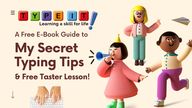
Return to flip book view
Top 5 Tips On How To Help Your Dyslexic Child Learn How to Touch Type Including a free interactive lesson top secrets that no other courses will tell you
Why is touch typing so important for a dyslexic child Hi my name is Wendy Petersen and for the last 9 years I have helped thousands of children and adults learn the amazing skill of touch typing I specialise in helping children to touch type who are dyslexic or have other processing disorders I understand how frustrating and upsetting it can be for them to get down their thoughts on paper quickly Learning to touch type takes away this problem freeing up the mind to concentrate fully on the task at hand without worrying about what the fingers are doing Work can get done quickly and effortlessly thereby building confidence and self esteem I hope you enjoy my tips on how you can help your child learn how to touch type as well as giving them a taster lesson where they can touch type some real keys and words Have fun and enjoy Wendy Course Director Type IT
How long will it take to learn The time it takes to learn is different for every child It depends on a number of factors including age manual dexterity sensory processing ability as well as the amount of practice your child puts into the lesson The most important thing to remember is that learning to touch type should not be rushed Going slowly helps the working memory to commit the finger patterns to long term memory Your child will need AT LEAST 10 hours of lesson time and another 10 hours more of practice time but they may need longer The effort will definitely be worth it
I m worried my child will struggle It s a common worry amongst parents that because their child may find reading and writing difficult that they may struggle learning how to touch type But it s not true I have worked with hundreds of children with dyslexia and I can reassure you that given time patience and practice they all end up as touch typists Learning to touch type takes time but it s so worth it for now and for the future
Oh no how are we going to fit this in Children are so super busy with homework and other extra curricular activities outside of school as well However learning to touch type doesn t have to be a burden Because it s fun many children quite enjoy the challenge Try and set aside 3 x 15 minute sessions each week for touch typing practice Some of our students like to do their work in the morning when they are feeling alert Setting up a reward system at home is also a wonderful way to make sure practice gets done Also don t forget once learnt never forgotten So unlike other skills it only has to be learnt ONCE
I m not sure my child will like it As a parent of a dyslexic child we want to help them but quite often feel guilty about bombarding them with yet another thing to add to their already hectic schedule However it doesn t have to be like that Try and make any learning experience fun and enjoyable for your child That way they will want to learn themselves without you having to nag them to do it So when you are looking at a touch typing programme or course make sure it has good content enjoyment value and offers positive feedback for your child Otherwise there s a chance they may resist or give up
Type The Letters Here
Type The Letters Here
Type The Letters Here
Type The Letters Here
Type The Letters Here
Type The Letters Here
Type The Letters Here
Type The Letters Here
Top 5 Tips On How To Help Your Dyslexic Child Learn How to Touch Type Including a free interactive lesson top secrets that no other courses will tell you
Top 5 Tips On How To Help Your Dyslexic Child Learn How to Touch Type Including a free interactive lesson top secrets that no other courses will tell you
Why don't I just join a freeonline course?